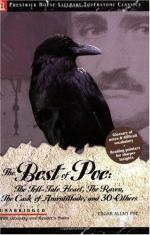|
This section contains 3,329 words (approx. 12 pages at 300 words per page) |

|
SOURCE: "Hawthorne's Transplanting and Transforming The Tell-Tale Heart'," in Studies in American Fiction, Vol. 23, No. 2, Autumn, 1995, pp. 231-41.
In the following excerpt, Kopley offers insights into the critical reception, principal themes, and structure of "The Tell-Tale Heart" as he argues that that Nathaniel Hawthorne, Poe's contemporary, used elements of the story in his novel The Scarlet Letter.
Nathaniel Hawthorne's novel The House of the Seven Gables (1851) has long been recognized as having an affinity with Edgar Allan Poe's tale "The Fall of the House of Usher" (1839), especially with regard to setting and characters;1 a reader may therefore wonder if Hawthorne's preceding novel, The Scarlet Letter (1850), also possesses an affinity with a Poe tale. In an early review of The Scarlet Letter (April 1, 1850), George Ripley noted several parallels between Hawthorne and Poe: "The same terrible excitement . . . the same minuteness of finish—the same slow and fatal accumulation of details...
|
This section contains 3,329 words (approx. 12 pages at 300 words per page) |

|


